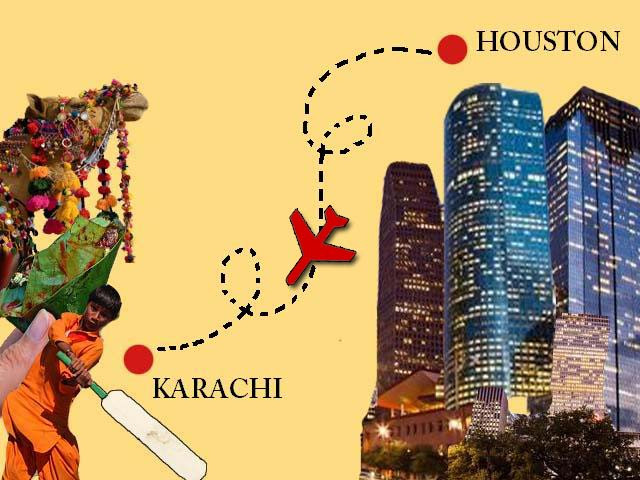The abrupt decision to move to Karachi from Houston was distressing. The realisation that it would be a move from Houston to Golimar was even more distressing.
The enduring flight bore anticipatory thoughts of what this foreign land would hold for me, if anything at all. Western media had successfully accomplished its goal of tarnishing Pakistan’s image in my eyes. This would be the first time I travel to Pakistan in 12 years after having lived abroad for all of my life.
As I walked out of Jinnah International Airport, the putrid stench of the third-world hit me like a sucker punch, nearly causing me to gag. The ride to the Golimar area from the airport in a rattling Suzuki truck was a near-spiritual experience as I found some strange sort of beauty in the dilapidated structures and debris around the city.
Golimar was colourful, to say the least. The chatter of children playing cricket, the smell of bun kebabs sizzling on a portable grill, the sight of an elderly man walking to the mosque, were all despondently underlined by poverty.
For the first few months in Karachi, I only spent time in Golimar and its neighbouring areas, consciously learning and absorbing everything around me.
Owing to my inclination towards anthropology, I expected to turn this unfortunate development into a beneficial learning experience. Thus, I started to construct my own renewed perception of Pakistan, based solely on my experiences towards my part of town.
The cultural differences were stark. For one, I could not fathom why everyone in my house drank multiple cups of hot chai during a day that reached temperatures over 40° Celsius.
I spent my first month in Karachi without coming across a single person who spoke English, which I found tremendously depressing.
I had seen Golimar, Liaquatabad, Nazimabad and all neighbouring areas, but I was neither impressed nor comfortable.
It wasn’t until later that I properly explored the ‘other side of the bridge’.
I travelled to Defence and Clifton in search of coffeehouses, bookstores, some remnant of a previously existing bohemian culture. I was pleasantly surprised to find everything I yearned for and more.
Once I had ventured into the Khayabans and Phases, I was confounded by the sheer contrast of the two worlds that coexisted in one city.
The economic inequality was immensely striking!
Paved roads, traffic signals, newly built stores and cafes were all a sight for sore eyes.
Furthermore, the debauchery and the intemperance and the luxuries of a first-world lifestyle were all being savoured right in front of me behind closed doors in Defence.
Young kids my age were roaming around the city in their imported cars with drivers. Even the wealthiest people I interacted with in the States did not have drivers. The concept seemed extremely bourgeoisie and pompous. Nevertheless, the prim and pampered residents of Defence whom I had met would not go to the nearest general store if they had to drive themselves.
Students from the more affluent universities threw parties that were totally at par with similar bashes in the US -- scantily clad girls, bottles and bottles of alcohol, mounds of cocaine, you name it.
I was already aware that the Islamic Republic of Pakistan was a ‘dry’ country and I was certain that people broke that law, because everyone drinks. What I didn’t anticipate was just how painless it was for one to acquire expensive, smuggled alcohol from bootleggers. I was taken aback as I watched a young man shell out Rs10,000 for a bottle of wine, which is what my uncle earns in a month and supports his family with.
The privileged and pretentious of Pakistan live more lavishly than their counterparts in the States. Even more disgusting is their dismayed proclamation of living in a third-world country. I have witnessed things in this city that my cousins in Golimar have never even heard of because they’re impoverished.
Alcohol flows, miniskirts abound, Prados roll, hash burns, and money talks. Meanwhile, my cousins back home get scandalised by the sight of a girl smoking a cigarette.
I continue to remain flabbergasted by this palpable economic disparity and the disdain it instills within me. There is virtually no middle class in Pakistan, it seems.
Moderation is crucial, with anything. This extravagant lifestyle is one that spoils a person, especially at a young age. Perhaps if the cream of the country focused their wealth on advancing their nation by helping to eradicate infectious diseases like polio and measles, for example, Pakistan would be in much better shape.
This is a working theory, but it appears that this socioeconomic divergence may be one of the root causes for the innumerable problems Pakistan is plagued with, such as unemployment, intolerance and lack of unity.
If these ‘rich kids’ are the next generation of Pakistan, then this country is officially Westernised.
Read more by Saif here or follow him on Twitter @AreYouSaif
From Houston to Golimar
I watched a young man spend Rs10,000 on wine, which is what my uncle earns in a month and supports his family with.


COMMENTS
Comments are moderated and generally will be posted if they are on-topic and not abusive.
For more information, please see our Comments FAQ